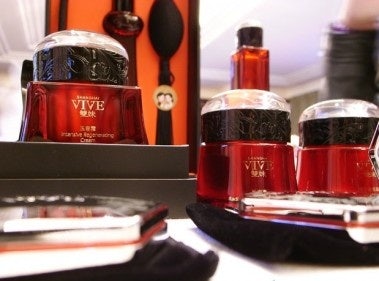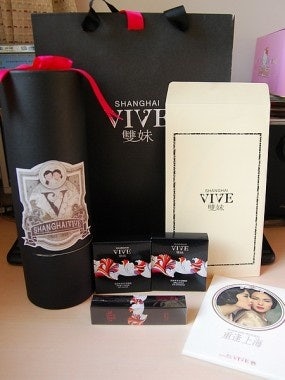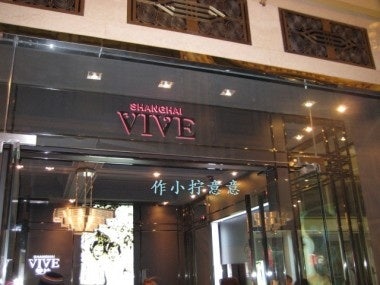Brand Officially Launched Last August With Flagship At Shanghai Peace Hotel#

Shanghai VIVE: "Made in Shanghai," not "Made in China" (Image: Annie Nu)
Last August, Jing Daily covered the launch of Shanghai VIVE -- a "reboot" of the Chinese cosmetics brand "Two Sisters" (shuangmei, 双妹), established in the late 1800s -- at Shanghai's recently reopened Peace Hotel. As we wrote at the time, despite the brand's Old Shanghai-heavy rebranding and slick new logo and packaging, the success of Shanghai VIVE's experiment in selling premium "made-in-China" cosmetics (priced comparatively with imported brands like Dior) was in no way a safe bet:
[A] 50-milliliter bottle of Shanghai VIVE perfume will cost around 1,000 yuan ($147) — pretty pricey when you consider most imported perfumes cost anywhere from 500-900 yuan.
This places Shanghai VIVE in the same price range as Chanel, Dior and other dominant luxury brands in the perfume segment. A gutsy move, especially considering that it’s far from certain that Chinese consumers will be willing to pay a premium for a local brand, no matter how well it’s packaged and marketed.
As always, we’ll have to take a “wait-and-see” approach with Shanghai VIVE. Will its target consumer be captivated by its “Paris of the East” flavor and the opulent surroundings of the company’s Peace Hotel boutique? Or will the “Old Shanghai” vibe fail to resonate outside of “New” Shanghai? Could Chinese consumers be willing to pay a premium over foreign brands for Shanghai VIVE’s localized products? Or will (foreign) brand worship be VIVE’s undoing?
So how has Shanghai VIVE been received since its official relaunch nearly five months ago? This week, iFeng looks at its rebranding effort -- spearheaded by DEM Inc. (橙果設計) founder Demos Chiang, grandson of Chiang Kai-Shek -- as well as its strategies for competing with international names in the still-foreign-brand-obsessed mainland China market. Translation by Jing Daily team:
With its 1080 yuan (US$163) "Yurong cream" and 220 yuan ($33) "Xiren" soap, Shanghai VIVE is clearly positioning itself as a true luxury brand. Shanghai VIVE's appeareance on the scene means that China's lack of a home-grown luxury cosmetics brand has come to an end.
In its comeback campaign, Shanghai VIVE decided to continue to use the "Qipao calendar girl" image originally used in the "Two Sisters" days. Meanwhile, parent company Shanghai Jahwa hired DEM Inc. to create the new logo, product packaging and store design. The grandson of Chiang Kai-shek, DEM Inc. founder Demos Chiang has become a key part of Shanghai VIVE's brand's resurrection. This is not only because he's a popular media figure and writer, but also because of the international perspective of his design team.
When preparing Shanghai VIVE's design, Demos Chiang said he did a lot of research about 1930s Shanghai, while also studying popular fashion magazines at the time. Finally, Chiang settled on a black and rose-red motif for the brand, feeling it best depicted the mysterious and sexy nature of Shanghai women.
Allegedly, after taking on the Shanghai VIVE project, Demos Chiang holed himself up in his great-grandmother's room in Shanghai for a week, in order to get a feeling for the flavor of Old Shanghai. DEM Inc.'s final "red and black luxury" vision for the brand didn't disappoint, with the firm saying its plans for Shanghai VIVE boiled down to "using the language of the world to tell Shanghai's story."

Shanghai VIVE's red-and-black design motif
The article goes on to look at the particular difficulties faced by upstart Chinese luxury brands at home, as they are often hobbled by resistance from European-brand-obsessed Chinese consumers. and illustrates how Shanghai VIVE has employed some clever branding tactics in response:
In the international market, "European-made" is synonymous with luxury goods, while "Made in China" still makes consumers think of cheap products. It's still very difficult to associate China with luxury goods. "In the minds of many people, luxury brands are always linked with Europe. The idea of an Asian luxury brand is still unthinkable," said Gucci president Patrizio di Marco. This is a key concern that many have about Shanghai VIVE.
Shanghai Jahwa has apparently long been aware of this. It has cleverly circumvented the biases of consumers, replacing "Made in China" with "Made in Shanghai." By making Shanghai -- an international metropolis -- its clear home base, Shanghai VIVE has been able to co-opt the Shanghai "brand" more easily. Through deliberate geographical association, Shanghai Jahwa is forging a unique local brand.
China is not lacking a traditional culture of luxury, as we can see from the food and clothing from the ancient imperial times. But that doesn't mean China will have enough "cultural self-confidence." "Local culture in China is not yet strong, and people still have an inherently narrow perception of luxury and culture, much of which is still heavily Western-focused," admitted Ye Maozhong. "As such, it's been very difficult for domestic Chinese luxury brands to get on track." By pulling only from the established "Shanghai Culture," Shanghai VIVE has a better chance to make an impact, as it can make a brand statement with the confidence necessary to gain a foothold.

Shanghai VIVE's first, and only, location at the Shanghai Peace Hotel (Image: Sina)
Wrapping up, the article looks at Shanghai VIVE's prospects for profitability. The writer quotes Shanghai Jahwa CEO Ge Wenyao, who has said he hopes VIVE can enjoy the same success as his company's lower-priced cosmetics sub-brands, Liushen and Herborist:
Shanghai VIVE is Shanghai Jahwa's marquee brand, and CEO Ge Wenyao has expressed great expectations for the company, often comparing Shanghai VIVE to world-class brands like Hermes and Louis Vuitton. This confidence comes from recent success: Before the launch of Shanghai VIVE, Shanghai Jahwa brands like Liushen and Herborist have seen six full years of profitability. Herborist is even making inroads in international markets.
Despite the success of Liushen and Herborist, Shanghai Jahwa doesn't want to follow their model with Shanghai VIVE. In contrast to Herborist, Shanghai VIVE doesn't use herbal ingredients as a selling point. Rather, it uses culture as its main selling point.
According to reports, over the next few years, Shanghai Jahwa will open 20-30 Shanghai VIVE locations throughout China. In terms of the timetable for profitability, Ge Wenyao said that he hopes to achieve profits "faster than we did from Herborist" -- or, in other words -- within three years.
Currently, all of Shanghai VIVE's packaging is imported from France, as "no domestic suppliers meet our requirements," according to Lei Yuanzong of the brand's design center. Added Lei, "It'll probably take 10 years for China to develop its own luxury capabilities." Nonetheless, Shanghai VIVE has begun to attract attention from the Western world. Though the brand isn't yet available overseas, a German investment group has expressed interest in discussing possibilities with Shanghai Jahwa. Ge Wenyao is clearly enjoying the attention his company is getting from the West, but said he'll only face increased pressure from it.